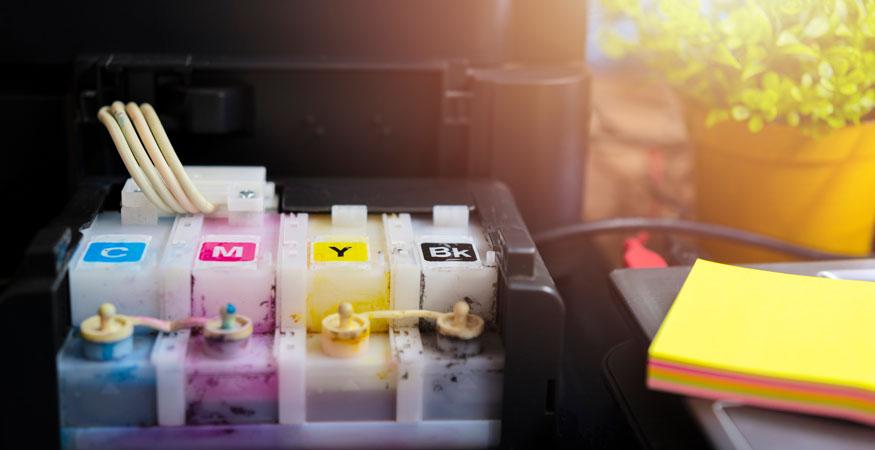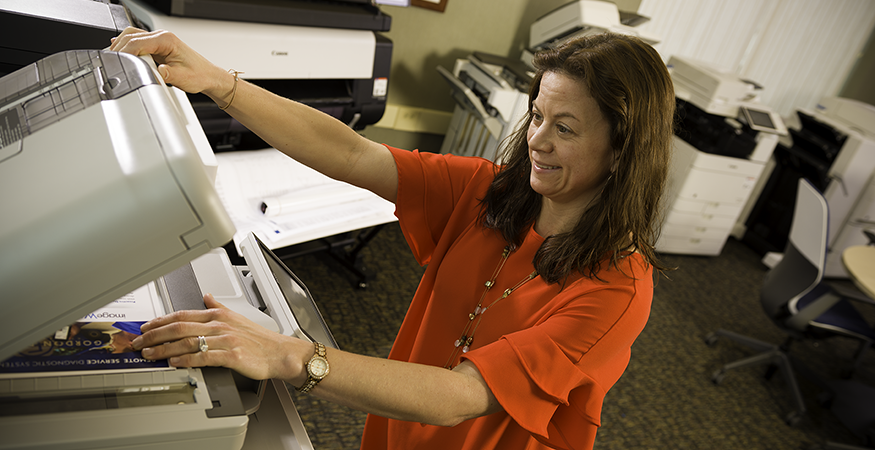Stocking up on ink or toner cartridges might seem like a good way to save money. But in the long run, it could become more expensive than you planned.
Even if you have storage room for extra ink or toner cartridges (and many organizations don’t) there are other factors to consider when planning for the consumable needs of your multi-function printer (MFP) fleet.
Let’s take a closer look at ink and toner cartridge usage and learn more about what to consider when evaluating your choices for MFP supply management.
- Facts About Ink Cartridges
- Facts About Toner Cartridges
- OEM vs. Compatible Cartridges
- Just-in-Time Cartridge Replenishment
- Toner Inclusive Contracts
- Cartridge Recycling
- How to Reduce Supply Waste and Save Money
CASE STUDY: Fleet-Wide Printing Case Study – FTI
Facts About Ink Cartridges
Printer ink cartridges often have an expiration date noted on their packaging. If the cartridge is used past this expiration date, manufacturers will typically not guarantee that the ink will work correctly in the device.
Being a liquid, expired ink tends to dry out and reduce the amount of usable ink inside of the cartridge. Dried ink could also cause blocked ink nozzles inside of your printer, resulting in frustrating downtime and costly repairs. We recommend not using expired ink cartridges as the risk is often not worth the amount of ink that may be usable.
If you do choose to keep extra ink cartridges on hand, be sure to keep them in their original manufacturer’s packaging until ready to use and store them upright, in a temperature and humidity controlled space, away from direct sunlight.
Facts About Toner Cartridges
Printers that use toner cartridges tend to be larger devices typically found in office environments. An advantage of using toner cartridges is that the toner inside is a powder (vs. ink which is a liquid). A powder will not dry out; however your method of storage may impact the serviceability of the toner cartridge when used in your printer.
Toner provides crisper, clearer images than printers than use ink. This makes toner-based devices more suitable for business or commercial applications printing high volumes.
Some toner manufacturers do include an expiration date on the packaging of their toner cartridges, while others do not. It is recommended to always check the instructions included with your MFP and read any specifications and recommendations about toner use and storage.
In general, toner cartridges are best stored laying flat in a temperature and humidity controlled area that is protected from excess dust. Toner cartridges may look expensive, but overall they are usually more cost effective than ink cartridges in the long run.
OEM vs. Compatible Cartridges
Consumables such as ink or toner cartridges are a necessary part of the everyday life of your printer. While manufacturers and device models typically recommend using a specific cartridge, consumers are often faced with the decision of purchasing original equipment manufacturer (OEM) cartridges or compatible cartridges.
OEM cartridges have been found to produce print images with better quality and commonly have a slightly longer lifespan than compatible cartridges. In addition, OEM cartridges promote customer confidence in optimal machine performance as they typically have a lower failure rate than competing compatible cartridges.
When working with a Managed Print Services (MPS) partner, OEM cartridges and service for printing devices are often wrapped together along with the monthly leasing payment. (NOTE: Always check a MPS proposal to verify what is included before you sign a contract.)
Just-In-Time Cartridge Replenishment
If you opt for just-in-time toner cartridge replenishment as a part of your MPS contract, a meter collection tool will be added to each of your contracted printing devices. This tool collects data from the usage meters within your devices and sends meter reports along with toner cartridge levels to a dashboard that can be viewed by you and your MPS partner.
The system will calculate the percentage of toner remaining in each cartridge and will compare the cartridge yield to calculate an estimated empty date. When it is estimated that a cartridge will be empty within approximately 20 days, the device will be added to a notification report that indicates to the MPS partner that the next toner cartridge should be shipped to the customer.
Toner Inclusive Contracts
Sometimes customers have their own workflow and specifications on how they would like to place orders for toner shipments. While just-in-time toner delivery works for the majority of organizations, occasionally an organization prefers to keep a supply of cartridges in storage or place their orders by phone, email, internet portal or app.
How you will order and receive your toner cartridges, should be discussed and decided prior to signing a contract with an MPS partner.
Cartridge Recycling
Many office supply stores accept empty ink cartridges. This can be a convenient way to dispose of empty cartridges from your home printer. Businesses and other organizations working with a MPS partner will typically have recycling programs available with complete instructions on how to send empty toner cartridges for recycling.
How to Reduce Supply Waste and Save Money
Managed print could be your secret weapon in the quest to reduce office supply waste and save money. Download your free copy of our 5 Most Frequently Asked Questions about MPS infographic and learn more about the advantages of managed print and how it can benefit both your IT team and your business’s bottom line.










